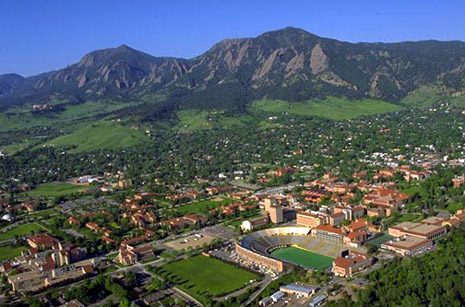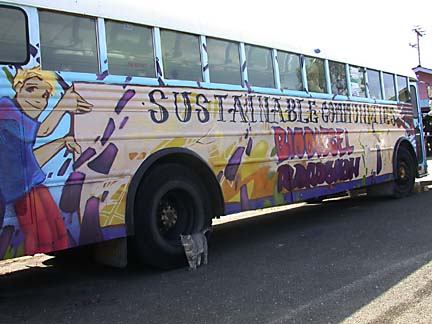Casa Blanca
Posted by Sabina
Part I
According to Perry, “Neighborhoods possess a certain unity which is quite independent of political boundaries.” Each neighborhood unit is classified by four heads: 1) the elementary school, 2) small parks, 3) local shops, and 4) residential environment. The Hill is a conglomeration of both college students and families. While it is the quintessential “party place” after dark on weekends (Thursday-Saturday) in Boulder, it is also home to two elementary schools, many local shops in a central shopping strip, and some parks (as well as a graveyard that is used as one). Given the diversity of people living in the area and the fact that the Hill is right next to the University of Colorado, there are fewer places for “play” and it has turned mostly into a “living space”. Many houses rented to college students try to fit as many people as possible in order to keep rent at a minimum. This has made the population density of the hill higher than average. More often than not the Hill businesses cater to college students over families. Fast and cheap food places make up the majority of local shops and there are no grocery stores to be found. There was a locally owned convenience shop, Delilah’s, but it just recently closed. Other local places revolve around university goods, music, and cafes.
Part II
Casa Blanca
The quintessential Hill house (left) is what my friends and I like to call "Casa Blanca". It is a relatively small house at the corner of 14th and Euclid with a lawn that is only lived in by college students and looks terrible and run down. The house across the street is a perfect match with it's school pride and very tasteful ad for atrocious beer with a scantily clad woman in the window. One block north is the "daytime Hill" with all the pizza joints you could ever ask for.
Heading south down 14th one could see that this was the Hill. The streets were filled with cars and a plethora of mailboxes lined the sidewalks. Continuing south, the Hill starts to become ambiguous. Between Cascade and Baseline the edge of the Hill seems to blur. The houses become cleaner and more manicured and the side of the street is sparse of parked cars. One may not feel as if you are on the Hill, but if someone asked where you were you would most likely say the Hill. As you drive west, the side of the street is cluttered and rows of rundown houses persist until 9th Street where you hit the cemetery.
The Hill is one of the most notorious areas in Boulder. However the boundaries and borders for The Hill seem to be ambiguous and open for interpretation. As a group, we decided that the southern edge of The Hill is baseline. While for many people this may in fact be the edge, there is some doubt as to if we count the homes on the south side of baseline as well. A roommate of mine grew up on the south side of baseline on 14th, and claims he was raised on The Hill. Therefore I believe as college students we see the southern edge as baseline because it is mainly family homes on the south side of baseline. But this means that the border is soft due to the question on if the other side of baseline is part of The Hill or not. When discussing the western edge, we ran into problems on exactly where it was again. As a group, we decided that 9th was the western edge, but again it is a soft edge. There are still houses past 9th, but they progressively become nicer and raise in value the more west you travel past 9th. We felt the cemetery serves as almost a barrier between the college homes and the family homes. Yet again though the western edge is ambiguous and raises a lot of questions as to what do we exactly include as The Hill.
In my opinion, other than the eastern border, all other edges of The Hill are soft. The eastern border, is the one border that I believe is hard, meaning precise and has no doubt where it begins. I believe if you asked any student, professor, local, or person familiar with boulder, that they would tell you that Broadway is the eastern edge. The hills western border could rise all the way up to chautauqua, or the edge of flagstaff. The southern border could include all the homes south of Baseline, possibly reaching as far as Table Mesa. While as college students we think of the hill as an area to eat, drink, and find some fun...I believe the edges of the hill may extend beyond the areas we venture to.
Hill Landmarks
Landmarks are a point of reference according to Lynch, something which is tangible or physical in nature. "They are usually a rather simply defined physical object: building, sign, store, or mountain." In the case of The Hill, all of these landmarks can be visible on the landscape. To begin I would like to focus on some general landmarks which can be used to identify The Hill.
Some may say The Hill is on the west side of campus, closer towards the flatirons. But this does little justice towards defining a landmark of The Hill since the flatirons are visible throughout Boulder. While it may be that one can count the number of flatirons to find the sections The Hill is nestled under, this is inconvenient. To a resident of Boulder saying the hill resides under the flatirons is as ubiquitous as saying, "just climb down from Chautauqua and you're on The Hill."
In addition, distant landmarks such as the flatirons are well know but only those unfamiliar with Boulder will use them as a landmark. This notion is parallel to Lynch's observation of the John Hancock Building in Boston. Moreover, as Lynch described, distant landmarks like the Flatirons only serve as guidance for some general direction. I am certain that more than one inebriated college student has guided themselves home with nothing more than the moonlight sparkle coming off the Flatirons.
 |
| Hey,where is Illegal Pete's on The Hill? O yea, its right under the first Flatiron. |
When we are on The Hill, we notice physical signs documenting its existence. To many these are a landmark, however they are numerous in nature and only give its gazers the general locality in which they are. These landmarks in my eyes are meant for those who lack knowledge about The Hill activities. Perhaps they serve as a guidance point for the incoming freshman and their parents. I like to think that families who live on The Hill (the areas with softer edges as Micheal described earlier) tell their children to never go into the part of the neighborhood with the green "The Hill" signs. Because if they ever catch them at The Fox Theater they are in big trouble.
After laying out what I believe are some very general landmarks of the Hill, landmarks which less knowledgeable persons use to justify its existence. I would now like to discuss the primary landmark on The Hill. In my opinion the central landmark which we all have used at one point or another in our time here at CU. The Fox Theater.

I base my opinion off the fact that The Hill is primarily known as a locale for University students. Its central landmark should also represent those values. The Fox Theater is easily identifiable in terms of appearance and location to residents of Boulder. It quintessentially represents the college environment of The Hill, bringing shows which no older adult would want to see.
Lynch noted that "there seems to be a tendency for those more familiar with a city to rely increasingly on systems of landmarks for their guides." The appearance of the theater, such as its illuminated lettering and signboard helps to mark the its existence on The Hill. Its address on 13th and College aids to its use as a landmark by allowing one to navigate to their Hill destination based off its location. Furthermore, the number of Fraternities and Sororities peppered within a 3 block radius further justifies the fact that the Fox Theater serves as a primary landmark of all things CU (whereby all things CU can be summed up by the Hill neighborhood.)
The Fox Theater has brought such acts as Skrillex, Big Head Todd and the Monsters, John Butler Trio along with many other smaller and less well know acts to the City of Boulder. The theater acts as a magnet which pulls persons from all throughout the city towards the Hill. Arguably the only other landmark which attracts such attention is The Sink. However, due to the broad number of acts which have performed, the Fox Theater has pulled vast numbers of persons from different walks of life to its door; more than I believe The Sink has.
I would like to touch on one last point about the Fox Theater. Its locations allows for students to funnel into 13th Street. Several nodes (the perpendicular streets to 13th Street) bring persons to the central hub of activity. The shopping district on The Hill serves as a major focal point and arguably it is its own landmark for the Hill. However, few buildings are left which exemplify the character of the Fox Theater. After the destruction of the Jones Drug Store and Rose Liquor only the Fox Theater was the last standing brother of the Old Hill shopping district.
For the above reasons, I classify the Fox Theater as the landmark on The Hill.
















0 comments: